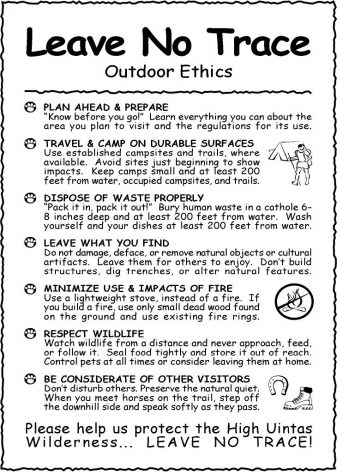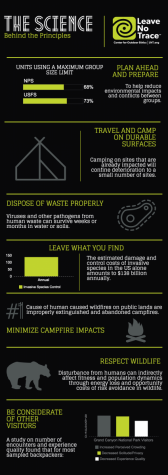Am I My Trail’s Keeper?
With only about seven more weeks of the semester left, that means summer is almost here: the prime season for some real mountaineering (not discounting that ice climbing and winter hiking are not real mountaineering). It is about time we start talking about ethical hiking.
Colorado has provided enjoyable recreation for every type of adventure seeker for years. We want to keep it that way. In recent years, too much public traffic on its precious trails and parks has resulted in erosion, deterioration of the landscape, and littered trash. Tourists as well as Colorado citizens often ignore wilderness ethics and proper stewardship.
According to a Denver Post article last year, 71% of Coloradans participate in outdoor recreation. As for hiking, the Colorado Fourteeners Initiative reported that Colorado’s 14,000 foot mountains saw 311,000 trips up the mountains in 2016. With that in perspective, it is easier to see how the habits of each individual have a large impact overall.
One organization that is dedicated to informing the public on outdoor stewardship is the Leave No Trace Center for Outdoor Ethics. They have developed seven principles to follow anytime you are in the outdoors. They are:


Most of these principles are self-explanatory, but full explanations can be found by clicking here. All of their research and findings relating to their seven principles can also be found here.
Hikers constantly veer off designated trails, stomping on fragile tundra and causing the paths to widen over time. Commonly called social trails, these undesignated paths cause serious problems with erosion if not checked. Sometimes it is necessary to detour off the main trail when it is blocked by snow or other conditions. However, when everyone does this, the ecosystem over time gets damaged. In his guidebook Colorado’s Fourteeners—From Hikes to Climbs, mountaineer Gerry Roach explains that when destroyed, “a patch of tundra… may take a hundred years for the plants to recover.”
A few summers ago, my friends and I ascended Grays and Torreys Peak, two very popular fourteeners. It was disheartening to see that at the start of the trailhead was a lost and found rock where climbers dumped random hats, sunglasses, an orphan shoe, used stinky socks and other items they found on the trail. My friend who lived out of state grabbed a pair of sunglasses as a souvenir and tried to clean up the trash, but it made me sad that they were there in the first place.
Often, the goal is to get out into the beauty of a natural environment and away from the human world, but littering allows our world to invade the natural. Most discarded items are not easily biodegradable. They remain on the ground for years, disrupting the otherwise gorgeous scenery. Animals are also tempted to mistake this trash for food and ingest it.
Parks and trails are special places that continuously draw people for release from the hectic and manicured world in which we live. It would be a shame if we did not take care of them for future generations to enjoy.
As Gerry Roach agrees “There is no environmental problem created by climbers that cannot be solved by climbers”. By hiking ethically, we can not only enjoy the beauty of Colorado, but help it stay that way.

Ashley Peoples is a second-year student at ACC. Although not a Colorado native, she got here as fast as she could! Colorado couldn’t be a more perfect fit for her sense of adventure and avid interests in rock climbing and hiking. After...









Nancy Stokvis • Mar 30, 2018 at 10:11 am
Great article! Glad you wrote about this problem. I’ve seen people tromping off trails through the vegetation and letting their dogs run off leash in the Open Space parks, too. It’s been getting worse and worse over the last few years. There are plenty of signs clearly stating stay on trails and dogs must be on leashes, but the offenders act as though the rules don’t apply to them – they have the “it’s all about me” attitude. Very sad to see our beautiful parks being ruined by these selfish people.